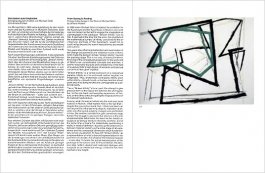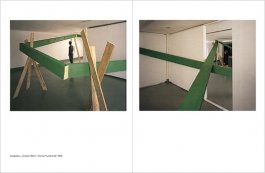Bonner Kunstverein 1988
From Seeing to Feeling
Energy-Interchange in the Work of Michael Gitlin
By Annelie Pohlen
In 1986 when Michael Gitlin completed his exhibition for the Kunstraum and the Kunstforum in Munich, one work was not carried out but left to engage the imagination as a photograph in the catalogue: “Broken Infinity” was its title. It seemed at the time that the work, the sculpture of the mathematical symbol of infinity, conceived for the architectural premises of the Kunstraum, would not or could not go beyond the state it had achieved as a model and a photo.
Two years later, after long deliberation and examination of the change occasioned by the exhibition rooms in Bonn, Gitlin made the decision to take “Broken Infinity” beyond the planning stage. This is not only of historical interest. Knowing of the conceptual background for this work and of Gitlin’s own concentrated concepts and activities, it seems reasonable to pause and consider how in the field of sculpture Gitlin’s high degree of semantic and spiritual concerns is here given impetus.
“Broken Infinity” is a verbal expression of a conceptual paradox. Infinity is, in its end result, neither tangible, nor imaginable. Thus, brokenness contradicts infinity since within infinity—should it exist—a fracture denotes a fixed point and in so doing revokes the unimaginable as a potential reality.
This is “Broken Infinity’s” focal point: The attempt to give physical form to the logical link between the Unimaginable, on the one hand, and everyday experience, of fracture, on the other, without negating the illogical premise of its material manifestation.
Leaving aside the reason behind why the work was never realized in Munich, what matters here is the fact that—despite the assumption made then—it has now been carried beyond the initial planning stage to realization at an-other site offering but a slightly changed venue and limited in time. The creative contradiction gets carried one stage further. The struggle to represent that which is, in the end, unrepresentable determines the basis for the debate on sculpture as being a medium inherently aesthetic and at the same time a means for intellectually questioning a reality in need of definition. It points up the ambivalence between material visibility as the initial stage of all experience and the conceptual dimension which fundamentally denies visualization. To have left “Broken Infinity” as a representation of what is beyond representation in the pure form of a model (for whatever the historical reasons) is one step. To tackle the actual materialization of the prototype is the second and, for this exhibition, the decisive step. Gitlin’s idealist and materialist dialogue with sculpture as an intellectual energy conductor has here reached a new height.
At the center of attention for over a decade there has been a debate on elementary perception that concerns more than the physical ability to see. The visible and the invisible, revealing and concealing, are essential categories. These determine the artist’s field of action, whereby the physical force used in dealing with the material to be shaped, I would think, stands in contrast to a highly intellectual struggle with art—inherent as well as existential issues. Fissuring, fracturing, and comparable methods, visibly a part of Gitlin’s work, belong traditionally to the repertoire of sculpture. And Gitlin’s efforts to make this process evident and comprehensible to everyone is not unique in contemporary sculpture. Self-identity develops from each indivual’s link to artistic procedure, aesthetic enquiry, and conceptual vision. In this context, “Broken Infinity” is as exemplary as it is transparently clear. The vision of infinity, nourished by mankind’s intellectual exertions from cultic, religious, philosophic as well as scientific sources to form a focal point, rasps and cracks on this raw (i.e., finite) material character of the wood, on the destructive act of breakage, and not least of all on the artistic necessity of breaking through the (dividing) walls. The “violent” transgression of this walled line, which in reality is a voluntary obstacle, accentuates from another standpoint the basic, creative determination toward ambivalence. Visibility as material finiteness and invisibility as potential infinity are not a result here of form but come about from the confrontation between sculpture and space/architecture. Not till it violates the dividing wall does the sculpture withdraw from visual totality. The walls are an integral part of the sculpture as well as its conceptual dimension.
As a material whole, “Broken Infinity” is not perceptible in a physical sense. To comprehend the structure it is necessary to “recollect” the parts in memory as one goes from room to room. The walls, as boundaries to be penetrated, indicate the point at which the visible and the invisible, seeing and feeling, come together to become perceptual correlations of the finite and the infinite, of matter and spirit.
“I have long been interested in the notion of an implied visual presence. That is to say, the color/shape of part of a work which exists but cannot be seen,” Gitlin writes in an unpublished text. What Gitlin expresses here for works from the 70s is valid for “Broken Infinity” in undiminshed, if altered, form. If, in a group of works that Gitlin touches on here, one part of the sculpture—a part that had in fact been worked on by the artist—remained invisible no matter from what vantage point in the room, it is true for the work in Bonn that perception from one place to another is restricted each time to different parts of the whole. The complete sculpture/installation is only perceivable by summing up the parts in an act of memory. In this way, Gitlin opposes one of the main interests of 20th century sculpture—that of seeing sculpture in the round. He thus heightens the basic contradiction between structured reality and the dimension of conceptual experience and gives it semantic expression in the title.
“[...] Felt/seen by implication” is that invisible part of a work made visibile by another part. The unseen as an integral component of the work, or better still, the unseen as a decisive part of the work. That which is clear for the ma-terial shape as a visual experience—through concrete vehicles like the material and its color, sculptural treatment like cutting, gouging, breaking up, etc.—demands active intuition as a process involving a spiritual dimension.
Sum and part, the reconstructibility of the parts back to their initial form or the break-up of the whole into its original single elements (as is the case with “Broken Infinity”) are categories of sculptural thinking as they are of the intellect’s reflection on reality.
In this context the drawings demand our heightened attention. These are not a sculptor’s drawings in the conventional sense. It is not sculptural structure that is concentrated in them but the conceptual dimension of the work, the referentiality of both focal points - visibility and intuition - to something beyond the visible. The drawings show very clearly the artist’s absorption with infinity and its breakdown. The seemingly intertwined linear network (that in color scale and color materiality suggests space as ambivalence, yet without denying the plan) is recognizably disconnected. The drawings are further stamped with the dynamic moment when the expansive energy of the line occupies space and explodes the flat surface. It is just this basic structure that characterizes those sculptural works of Gitlin, which in their unwieldy yet fragile linearity, and usually from the vantage point of the wall, determine the space around them. In contrast, the free standing sculpture, through the splinter and refraction of a dense material, and based on the relation of dismantled parts, transposes whole and fragment into a state of tension. The dynamic, linear components in “Broken Infinity” intensify into a spatial presence as an expression of the energy interchange between material being and the mind’s dynamism. Immovable matter and irresistible spirit create frictional energy from which the vision of infinity receives its quickening impulse. This in turn is sparked into being by the finite presence of a material obviously banal and manifestly incapable of making the most incendiary vision of the history of thought come alive visually and tangibly.
By taking for the installation disposable wood of the simplest kind used for everyday scaffolding, framework and other ad hoc purposes, and by placing the three-dimensional broken line on primitively constructed supports, Gitlin underlines the fact that material form is determined by the finiteness of all material reality, a fact that is a basic prerequisite to all spiritual efforts aspiring to break through these limits. Tension and repose are the coordination of the dynamic energy between physical presence and intuitive experience.
Where Gitlin uses color, as in “Broken Infinity”, or where he sets the porous materiality of plaster and other materials that are vivid in texture into relationship with the dominant material, one tends to speculate on color as an expression of content. In particular, the intensive pre-occupation with black and white in earlier works tempts you to speculate on the meaning of these (non)colors. The way Gitlin uses color makes one aware of its emotional quality which stimulates and highlights the sculptural forms.
To give form to a vision of infinity accepts the possible temptation to project into it an expression of sublimity and pathos. Gitlin’s work rejects any step in this direction. “Broken Infinity” is not even available for further use. As a vision, infinity is physically broken for the duration of the exhibit. Afterwards, the material can be given over to its normal industrial use or left as waste. What remains is the memory of an attempt (defined by a precise sculptural concept and its execution) to approach an idea as form. What remains is the intuitive knowledge of what the relationship between sculptural concept and execution is on one hand, and a spiritual experience of reality on the other.


